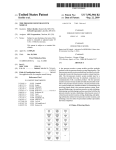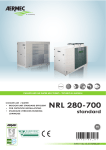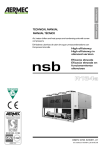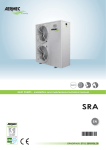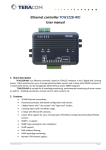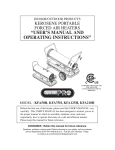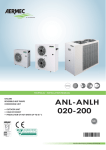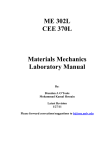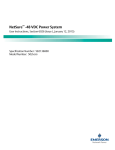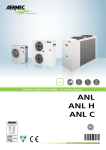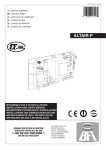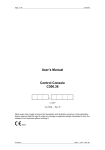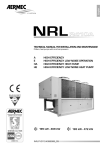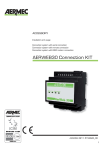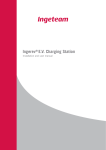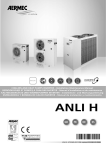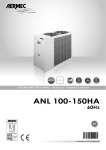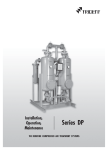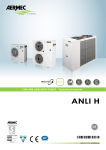Download WSH manuale tecnico - installazione
Transcript
English WSH R134a TECHNICAL MANUAL - INSTALLATION - MAINTENANCE Water to water chiller, with screw compressors ❄ 166 kW÷ 672 kW IWSHPY. 0809. 4471121_00 ❊ 183 kW ÷ 784 kW Dear Customer, Thank you for choosing an AERMEC product. It is the result of long experience and design-specific research.The article has been made of materials of the highest quality and incorporates cutting edge technology. In addition, all our products bear the EC mark indicating that they meet the requirements of the European Machine Directive regarding safety. The standard of quality is permanently being monitored and AERMEC products are therefore a synonym of Safety, Quality and Reliability. The data might undergo modifications considered necessary for the improvement of the product at any time, without the obligation for any notice thereof. Thank you again. AERMEC S.p.A 2 Summary 13.3. 13.4. 13.5. 13.6. 13.7. Compressor fuses note ..................................................................... 18 Double high pressure switch ........................................................... 18 High pressure transducer................................................................ 18 Low pressure transducer ................................................................. 18 Refrigerator circuit safety valves .................................................. 18 Product identification ......................................................................5 14. 14.1. Dimensions .......................................................................................19 Dimensional tables............................................................................... 19 4. 4.1. 4.2. 4.3. Unit description .................................................................................6 Versions available ....................................................................................6 Available versions ....................................................................................6 Configurator...............................................................................................6 15. 15.1. Weights and centre of mass .....................................................20 Percentage distribution of weights on supports .................... 21 5. 5.1. 5.2. 5.3. 5.4. 5.5. Description of components ...........................................................7 Refrigerating circuit ...............................................................................8 Frame ...........................................................................................................8 Safety and control components ........................................................8 Electrical components ...........................................................................8 Electronic regulation ..............................................................................8 16. 16.1. Handling .............................................................................................22 Instructions for lifting .........................................................................22 17. 17.1. 17.2. 17.3. Safety warnings and regulations of installation ...............23 Safety warnings .....................................................................................23 Selection of the installation location.............................................23 Positioning ...............................................................................................23 6. Accessories .........................................................................................9 7. Technical data ..................................................................................10 18. 18.1. 18.2. Hydraulic circuit .............................................................................24 WSH Internal hydraulic circuit........................................................24 WSH external hydraulic circuit (not supplied) .........................24 8. 8.1. Operational limits ........................................................................... 11 Design date dir 97/23/ce...............................................................11 9. 9.1. 9.2. 9.3. 9.4. Corrective factor ...........................................................................12 Cooling capacity and input power .................................................. 12 Heating capacity and input power ................................................. 13 For ∆t different from the rated value.......................................... 13 Fouling factors ....................................................................................... 13 19. 19.1. 19.2. 19.3. 19.4. Position of hydraulic connections ............................................25 Standard version (°) ............................................................................25 Quiet operation version (L) ...............................................................25 Desuperheater version (D)...............................................................26 Low noise with desuperheater version (DL) .............................26 20. 20.1. Electrical connections .................................................................. 27 Electrical data ........................................................................................ 27 10. 10.1. Ethylene glycol solution................................................................14 How to read glycol curves ................................................................ 14 11. 11.1. 11.2. Pressure drop ................................................................................16 Evaporator pressure drops in cooling operation ................... 16 Condenser pressure drops in cooling operation .................... 16 21. 21.1. 21.2. 21.3. Putting into service .......................................................................28 Preparation for commissioning .....................................................28 Commissioning ......................................................................................28 System discharge ...............................................................................29 12. 12.1. 12.2. Sound data ........................................................................................ 17 Sound power............................................................................................17 Sound pressure......................................................................................17 22. 22.1. 22.2. Maintenance ....................................................................................29 Maintenance warnings .....................................................................29 Extraordinary maintenance .............................................................29 23. 23.1. Disposal..............................................................................................30 Disconnecting the unit....................................................................... 30 13. 13.1. 13.2. Control and safety parameters setting ...............................18 Compressor magnetothermal switch 400v ............................ 18 Compressor thermal cut-out ......................................................... 18 24. 24.1. Improper uses .................................................................................30 Important safety information ......................................................... 30 1. 1.1. 1.2. Warnings on the documentation ................................................5 Intended use ..............................................................................................5 Conservation of the documents ........................................................5 2. Essential safety rules ......................................................................5 3. To install the unit, please observe the safety warnings included in these instructions Danger: moving parts Danger: cut off power supply Danger: high temperature General danger Danger: power supply i Useful information and warnings 3 AERMEC S.P.A. I-37040 Bevilacqua (VR) Italy – Via Roma, 44 Tel. (+39) 0442 633111 Fax 0442 93730 – (+39) 0442 93566 www.aermec.com - [email protected] WSH SERIAL NUMBER DECLARATION OF CONFORMITY We, the undersigned, declare on our own exclusive responsibility that the object in question, so defined: NAME WSH TYPE CHILLER, HEAT PUMP WATER TO WATER Model To which this declaration refers, complies with the following standardised regulations: CEI EN 60335-2-40 Safety regulation regarding electric heat pumps, air conditioners and dehumidifiers CEI EN 61000-6-1 CEI EN 61000-6-3 Electromagnetic immunity and emission in residential environment CEI EN 61000-6-2 CEI EN 61000-6-4 Electromagnetic immunity and emission in industrial environment EN378 Refrigerating system and heat pumps - Safety and environmental requirements UNI EN 12735 Round weldless copper pipes for air conditioning and cooling UNI EN 14276 Pressure equipment for refrigerating systems and heat pumps Thus meeting the essential requisites of the following directives: - LV Directive: 2006/95/EC - Electromagnetic Compatibility Directive 2004/108/EC - Machine Directive 98/37/EC - PED Directive relating to pressure equipment 97/23/EC In compliance with Directive 97/23/EC, the product meets the Full quality assurance procedure (module H) with certificate no. 06/270-QT3664 Rev.3 issued by the notified body no. 1131 CEC via Pisacane 46 Legnano (MI) - Italy Bevilacqua 14/12/2007 Marketing Director Signature 4 1. 1.1. WARNINGS ON THE DOCUMENTATION INTENDED USE WSH AERMEC chillers have been built according to the technical standards and the recognised safety regulations. These units have been designed and manufactured for cooling and must be used accordingly, and taking into account their performance characteristics. There may still arise risks for the safety of the user or third parties, or even damage to the units and other objects, in case of improper use. Any use not specifically indicated in this manual is forbidden. Therefore, AERMEC shall not be held responsible for any damage whatsoever resulting from the non-compliance with these instructions 1.2. CONSERVATION OF THE DOCUMENTS Deliver the following installation instructions with all the complementary documentation to the user of the unit, who shall be responsible for keeping the instructions so that they are always available when needed. READ CAREFULLY THIS CHAPTER, the unit must be installed by qualified skilled 2. Remember that the use of products that use electric power and water carries the compliance with some essential safety rules such as: The use of this unit is not intended for people (including children) with any physical or mental disability or any sensory impairment nor for people lacking experience and knowledge, unless they are supervised or instructed on the use of the unit by a person responsible for their safety. Children should be supervised in order to make sure that they do not play with the unit. personnel, in compliance with the national legislation in force in the country of destination. The unit must be installed in such a way as to make all maintenance and/or repair operations possible. The warranty of the device does not in any case cover costs incurred as a result of motorised ladders, scaffolding or any other lifting systems made necessary to carry out the operations under warranty. The warranty shall not be valid if the indications mentioned above are not observed. ESSENTIAL SAFETY RULES It is forbidden to carry out any technical or maintenance operation before disconnecting the unit from the mains by positioning the system and control panel main switches on “off”. It is forbidden to modify safety or regulation devices without the manufacturer's authorisation and indications It is forbidden to pull, disconnect or twist the outcropping electrical cables of the unit even if it has been disconnected from the mains It is forbidden to leave containers and flammable substances near the chiller. 3. It is forbidden to touch the unit with wet parts of the body and bare feet. It is forbidden to open the access doors to the unit internal parts, without having first turned off the system main switch. It is forbidden to spread, leave or keep the packaging material within the reach of children as it may be a possible source of danger. PRODUCT IDENTIFICATION WSH can be identified by: - Packaging label that includes the product identification data - Technical card Placed on the electronic box side sill. NOTE If the identification plate, or any other means to identify the product, is tampered with, removed or missing, installation and maintenance operations are hampered PACKAGING LABEL TECHNICAL CARD 5 4. UNIT DESCRIPTION The units from the WSH series are water chillers water condensed for residential and industrial use. The machine is designed for the management of both hydraulic circuits: (evaporator and condenser); therefore, it can be used not only as a water chiller but also to produce hot water. The commutation between "COOL HEAT" is obtained by managing the cooling circuit. The whole series includes models with one or two twin-screw compressors and are fitted with star - delta start to reduce the starting current. All the units are tested and delivered complete with refrigerant load and oil, (it will be necessary only to make hydraulic and electrical connections on site). All units have a protection class of IP20 . The new WSH series is characterised by the use of refrigerant R134a, which allows reaching performances significantly superior to equivalent products that operate with R407C. This is also the result of a thorough study and dimensioning of all the internal components in order to make the most of the refrigerant gas characteristics. 4.1. 4.3. 9 10 11 12 13 WSH 2502 X ° D ° ° ° (1) Code WSH 4, 5, 6, 7 Size 6 With the aid of the configurator, it is possible to set up and then order the chiller that best suits the needs of users or whoever stands in for them. CONFIGURATOR 8 9 AVAILABLE VERSIONS CAUTION Before each start-up operation of the unit (or at the end of each extended pause period) it is extremely important to preheat the oil in the compressor casing, by means of the suitable electric 4,5,6,7 8 4.2. VERSIONS AVAILABLE - “HEAT PUMP (H)” 1,2,3 Field 1, 2 ,3 heaters, during at least 8 hours. The casing heating element is automatically powered when the unit pauses so that the unit is kept powered up. 0701 - 0801 - 0901 - 1101 - 1402 - 1602 1802 - 2002 - 2202 - 2502 Field of use ° Standard with processed water above +4"C X With electronic thermostatic valve that permits: - Chiller water up to - 6°C - Control of the cooling capacity with continual modulation (25 - 100%) Model ° Standard 10 Heat recovery units ° Without recovery units D Desuperheater 11 Version ° L Standard Quiet operation 12 Heat exchangers ° Standard according to PED 14 Power supply ° 3~ 400V - 50 Hz with fuses 2 3~ 230V - 50 Hz with fuses 4 3~ 230V - 50 Hz with thermomagnetic switches 5 3~ 500V - 50 Hz with fuses 8 3~ 400V - 50 Hz with thermomagnetic switches 9 3~ 500V - 50 Hz with thermomagnetic switches ELECTRONIC VALVE "ELECTRONIC EXPANSION VALVES" are characterised by a high regulation capacity that allows compressors to always work in the best possible operating conditions (compatible with the outdoor ambient conditions). In winter it is therefore possible to work with very low condensation pressure, improving the efficiency of compressors and reducing power consumption. With the electronic valve in our chillers, temperature adjustment is more efficient, as it is possible to obtain lower working temperatures making the best use of the evaporator surface. Besides, the system does not require future settings or adjustments, since the electronic valve operates continuously its control function according to the parameters obtained from the transducers, keeping optimum overheating values. Apart from better pressure conditions, there are better temperature conditions for the compressors, keeping discharge temperatures lower than the ones obtained when using the standard thermostatic valve. This results in a longer service life for the compressor and a reduction in the number of failures. To summarise, the advantages of using the electronic valve are: - Energy saving in the system consumption levels - Better working conditions for compressors (lower pressure and lower discharge temperature), which results in less failures and a reduction in the maintenance costs. - Continuity of performance throughout time - Less deterioration of the compressor mechanical parts and of the lubricating oil - Repeatability of the adjustment and energy consumption results throughout time. All this in acknowledgement of AERMEC commitment to and respect for the problems related to energy saving and conscious and socially responsible use of the available resources. DESCRIPTION OF COMPONENTS 14 5. 11 8 7 6 5 4 3 12 2 13 1 Example WSH 1802 ° KEY 1 2 3 4 5 9 10 6 7 8 9 10 11 12 13 14 Compressors Liquid indicator Filter drier Economiser Thermostatic valve economiser Solenoid valve economiser side Filler valve One directional valve Evaporator Condenser Cycle inversion valve Safety valve (low pressure side) Safety valve (high pressure side) Electronic box 7 5.1. REFRIGERATING CIRCUIT Compressors Semi hermetic high-efficiency bi-screw compressors, with a cooling capacity regulation by means of continuous modulation from 40 to 100% (from 25 to 100% with electronic valve) and fitted with: - Thermal motor protection - Oil discharge temperature check - Electric heater for the heating of the oil casing with the compressor at a standstill - Reset button. Exchanger (condenser) Of the plate type (AISI 316), it is insulated externally with closed cell material to reduce thermal dispersions. Exchanger (evaporator) Of the plate type (AISI 316), it is insulated externally with closed cell material to reduce thermal dispersions. Economiser Plate type (AISI 316). This allows the additional cooling of the refrigerant exiting the condenser and at the same time creates a vapour to be injected in an intermediate point of the condensing process; reducing both the delivery temperature as well as the electrical absorption. Filter drier Of the mechanical type made of ceramics and hygroscopic material able to trap impurities and any traces of humidity in the cooling circuit. Liquid indicator For checking that the refrigerant gas load and any humidity in the cooling circuit. Thermostatic valve The mechanical type valve with outside equaliser on the evaporator outlet modulates the gas flow to the evaporator dependent on the thermal load in such a way as to ensure the proper intake gas degree of overheating. Thermostatic valve (economiser) The mechanical type valve with outside equaliser on the economiser outlet, on the inlet of the compressor to improve performance. Solenoid valve The valve closes when the compressor 8 turns off, preventing the flow of refrigerant gas towards the evaporator. in the case of abnormal operating pressures. One way valve This allows the refrigerant to flow in just one direction. 5.4. Mechanical filter Positioned in the liquid injection line to the compressor, it retains the impurities that may be present in the refrigerant circuit. 5.2. FRAME Load-bearing structure Made of hot galvanised steel sheet of adequate thickness, it is painted with polyester powders able to resist the atmospheric agents over time. Colour RAL 9002. Acoustic protection cover (silenced versions) IT is made of hot galvanised steel sheet of adequate thickness, with internal acoustic insulation, and externally painted with polyester powders able to resist the atmospheric agents over time. Colour RAL 9002. 5.3. SAFETY AND CONTROL COMPONENTS High pressure switch (manual + automatic) Factory-calibrated, it is placed on the high pressure side of the cooling circuit, it shuts down compressor operation in the case of abnormal operating pressure. Low pressure transducer It makes it possible to show the value of the compressor's intake pressure (one per circuit) on the microprocessor card display. Placed on the low pressure side of the cooling circuit, it shuts down compressor operation in the case of abnormal operating pressure. High pressure transducer It makes it possible to show the value of the compressor's delivery pressure (one per circuit) on the microprocessor card display. Placed on the high pressure side of the cooling circuit, it shuts down compressor operation in the case of abnormal operating pressure. Cooling circuit safety valves (HP - LP) Calibrated to 22 bar HP and 16.5 LP, they cut in relieving the overpressure ELECTRICAL COMPONENTS Electrical panel Contains the power section and the management of the controls and safety devices. This conforms with standard CEI 60204-1, and electromagnetic compatibility directives EMC 89/336/CEE and 92/31/CEE. CPCE valve Hot gas injection device up stream of the evaporator, fitted on the partial or total heat recovery versions. NOTE Furthermore, all the cables are wired for immediate recognition of all the electrical components. Door lock knife switch THE electrical panel can only be accessed by cutting off power using the opening lever on the panel itself. This lever can be locked in place using one or more padlocks, during maintenance in order to prevent the machine being powered up accidentally. Control keypad Provides full control functions. For a detailed description of the keypad refer to the user manual. - secondary thermomagnetic switch protection 5.5. ELECTRONIC REGULATION Electronic regulation on the "WSH" chillers consists of control cards (pCO2) for each compressor connected to each other in a network and a control panel with display. In the case of models with more compressors, the card that controls compressor 1 is the "MASTER" card, while the others are "SLAVE". On each card, the transducers, loads and alarms corresponding to the compressor that commands are connected, while the general machine ones are connected only on the "MASTER card. Microprocessor - Remot e on/of f wit h ext ernal contact without power - Multilingual menu - Phase sequence control - Independent control of individual compressors - Ammeter transformer - Cumulative failure block signalling - Alarm log function - Daily/weekly programming - Inlet/outlet water temperature display - Alarm display - Full proportional regulation of the output water temperature - Programmable timer function - Function with double setting point connected to an external contact - Interfaceability with the Modbus protocol (accessory) - Pump control - Compressor rotation control Analogue input from 4 to 20 mA Outside air temperature sensor “Always Working” function. In the case of critical conditions (e.g. an ambient temperature that is too high) the machine does not stop but is able to regulate itself and provide the maximum power that can be generated in those conditions. - Self adapting operating differential “Switching Histeresys” to ensure the correct compressor functioning 6. ACCESSORIES 0701 0801 0901 1101 1402 1602 1802 2002 2202 2502 Through this accessory it is possible to connect the unit with BMS supervision systems with electrical standard RS 485 and MODBUS type protocol. • • • • • • • • • • AER485P2 AVX Sprung vibration damping supports. ° D PRV 665 665 665 665 665 665 666 666 662 662 662 662 662 662 663 663 664 664 664 664 This allows the refrigerator command operations to be given from a distance. • • • • • • • • • • The ROMEO device makes it possible to remotely control the chiller from an ordinary cell phone with WAP browser, it also makes it possible to send alarm and pre-alarm SMS to up to three GSM cell phones even if they are not fitted with the WAP browser. The set includes the AER485. The accessory AER485P2 must be added to this kit. • • • • • • • • • • ROMEO RIF (on the 400V - 3 - 50 HZ VERSIONS ONLY) at all times even in plants with a low water content or insufficient flow rates. This system reduces the compressor wear - The PDC “Pull Down Control” system to prevent the activation of the power steps when the water temperature is approaching the set point quickly. It optimises the operation of the machine both when running normally or when there are load variations, thereby assuring top machine efficiency in all situations (1) Parallel connection with the motor makes the reduction of input current possible. 161 161 201 241 161 x 2 161 x 2 201 x 2 201 + 241 241 x 2 301 x 2 MULTICHILLER Control system to command, turn on and off the individual chillers in a system in which several units are installed in parallel. It is possible to select it among different command logics: sequential, homogenous, combined. The accessory is delivered in IP65 box. • • • • • • • • • • AKW: ACOUSTIC KIT This accessory allows additional reduction of the noise by means of: - Hood of the machine optimised by high density lead free materials which allow further reduction of vibrations. L L L L L L L L L L (1) Accessory that can only be installed in the factory 9 7. TECHNICAL DATA WSH COOLING ONLY Cooling capacity: Total input power Evaporator water flow rate Evaporator pressure drop Condenser water flow rate Condenser pressure drop kW kW l/h kPa l/h kPa HEATING Heating capacity Total input power Condenser water flow rate Condenser pressure drop Evaporator water flow rate Evaporator pressure drop kW kW l/h kPa l/h kPa ENERGY INDICES EER EEC COP EEC W/W ELECTRICAL DATA Power supply Total input power Maximum current Peak current V A A cool hot FLA LRA A A 0701 166 36 28550 23 34740 30 0801 196 41 33710 24 40760 31 0901 217 47 37320 22 45410 30 1101 270 57 46440 27 56240 36 1402 360 76 61920 43 74990 57 1602 428 88 73620 47 88750 62 1802 466 99 80150 48 97180 65 183 44 31480 24 23910 15 210 50 36120 23 27520 15 237 300 420 57 72 98 40760 51600 72240 23 29 57 30960 39220 55380 14 18 27 490 116 84280 62 64330 29 540 620 700 784 125 144 162 176 92880 106640 120400 134850 63 72 79 90 71380 81870 92540 104580 29 32 36 40 4,61 C 4,16 B 4,78 B 4,20 B 4,62 C 4,16 B 4,74 B 4,17 B 65 81 124 163 73 91 144 192 80,6 101 162 229 twinscrew 1 1/1 twinscrew 1 1/1 twinscrew 1 1/1 4,74 B 4,29 B 2002 2202 526 594 109 120 90470 102170 59 65 109220 122810 79 88 2502 672 138 115580 74 139320 101 4,86 B 4,22 B 4,71 B 4,32 B 4,83 B 4,31 B 4,95 B 4,32 B 4,87 B 4,45 A 100 130,5 182 300 400V-3-50Hz 135 146,5 178,5 210 248 288 287 336 162 221 324 391 187,5 256,5 344 462 210 291 364 482 242 320 430 575 twinscrew 1 1/1 twinscrew 2 2/2 twinscrew 2 2/2 twinscrew 1+1 2/2 twinscrew 2 2/2 twinscrew 2 2/2 Compressors Type Number Number per circuit n° n°/n° twinscrew 2 2/2 CAPACITY CONTROL Capacity control VT VT ° x EVAPORATOR Type Number Hydraulic connections CONDENSER Type Number Hydraulic connections SOUND DATA Sound power Sound pressure DIMENSIONS - outdoor installation (°) Height L Height Width Length (°) Weight Weight L % % 1 V/3" 1 V/3" 1 V/3" 1 V/3" Plates 1 1 V/3" V/3" 1 V/3" 1 V/3" 1 V/3" 1 V/3" n° 1 V/3" 1 V/3" 1 V/3" 1 V/3" Plates 1 1 V/3" V/3" 1 V/3" 1 V/3" 1 V/3" 1 V/3" dB(A) 86.0 54.0 86.0 54.0 86.0 54.0 92.0 60.0 89.0 57.0 89.0 57.0 89.0 57.0 93.0 61.0 95.0 63.0 95.0 63.0 2050 2120 809 2960 1391 1622 2050 2120 809 2960 1443 1674 2050 2120 809 2960 1506 1737 2050 2120 809 3360 1946 2206 2050 2120 1249 3060 2276 2542 2050 2120 1249 3060 2350 2616 2050 2120 1249 3060 2423 2689 2050 2120 1249 3460 2872 3168 2050 2120 1249 3460 3309 3605 2050 2120 1249 3460 3407 3703 n° Type/ø dB(A) mm mm mm mm kg kg DATA STATED ACCORDING TO EN14511:2004 Automatic - Processed water temperature 7 °C - Condenser inlet water temperature 30 °C - ∆t 5k 10 40-100 40-100 40-100 40-100 20-100 20-100 20-100 20-100 20-100 20-100 25-100 25-100 25-100 25-100 12.5-100 12.5-100 12.5-100 12.5-100 12.5-100 12.5-100 Heating - Processed water temperature 45 °C - Evaporator inlet water temperature 10 °C - ∆t 5k - Sound pressure measured 10 m. away in the open, with direction factor Q=2 according to ISO 3744 - Sound power The Aermec sound power value is determined on the basis of measurements taken in accordance with the ISO 9614-2 standard, in compliance with what is required by the EUROVENT Certification 8. OPERATIONAL LIMITS Condenser outlet water temperature °C Field of use ( ° ) 55 50 45 40 35 30 25 -6 -4 -2 0 2 4 6 8 10 12 14 16 Field of use ( X ) Evaporator outlet water temperature °C KEY Glycol operation Standard operation 8.1. DESIGN DATE DIR 97/23/CE HIGH PRESSURE SIDE LOW PRESSURE SIDE Maximum pressure allowable bar 22 16.5 Maximum setting allowable °C 120 55 Minimum temperature allowable °C -10 -10 11 9. COOLING CAPACITY AND INPUT POWER - “STANDARD VERSIONS” 1.70 - “HEAT PUMP IN COOLING OPERATION VERSIONS” 1.60 1.50 55°C The cooling capacity yielded and the input electrical power in conditions other than rated conditions are obtained by multiplying the rated values (Pf, Pa) by the respective correction coefficients (Cft, Cpa). The following diagrams are used to obtain the correction coefficients to be used for the units, in the different versions, in cooling operation; next each curve the external air temperature to which it refers is shown. 1.40 50°C (Ca) 1.30 45°C 40°C 1.20 35°C 1.10 30°C 1.00 0.90 25°C 0.80 0.70 Condenser outlet water temperature °C 9.1. CORRECTIVE FACTOR -6 -5 -4 -3 -2 -1 0 1 2 3 4 5 6 7 8 9 10 11 1213 14 15 16 Evaporator water temperature (∆t=5°C) KEY: Cf = Ca = Cooling capacity correction coefficient Input power correction coefficient NOTE: FOR THE X VERSIONS with temperatures below 4 °C contact the company FOR ∆T DIFFERENT FROM 5°C to the evaporator refer to Tab.9.3.1 for cooling capacity and input power correction factors. To account for exchanger soiling, apply the relative fouling factors (tav. 9.4.1) 12 1.40 1.30 1.20 1.10 1.00 (Cf) 0.90 0.80 °C 30 °C 25 C 35° C ° 0 4 C 45° C 50° C ° 55 0.70 0.60 0.50 0.40 0.30 -6 -5 -4 -3 -2 -1 0 1 2 3 4 5 6 7 8 9 10 11 1213 14 15 16 Evaporator water temperature °C (∆t=5°C) Condenser outlet water temperature °C 1.50 9.2. HEATING CAPACITY AND INPUT POWER 1.50 1.40 The yields are intended as net of the defrosting cycles. 1.30 55°C 1.20 50°C 45°C (Ca) 1.10 40°C 35°C 1.00 090 30°C 0.80 25°C 0.70 0.60 -6 -5 -4 -3 -2 -1 0 1 2 3 4 5 6 7 8 9 10 11 1213 14 15 16 Evaporator water temperature (∆t=5°C) 1.50 1.40 ° 30 °C 35 C ° 4 0 °C 405°C 5 °C 55 C 1.30 KEY: Ct = Ca = Heating capacity correction coefficient Input power correction coefficient 1.20 °C 25 (Ct) 1.10 1.00 0.90 0.80 0.70 0.60 9.3. FOR ∆T DIFFERENT FROM THE RATED VALUE For ∆t different from 5°C to the evaporator refer to Tab.9.3.1 for cooling capacity and input power correction factors. To account for exchanger soiling, apply the relative fouling factors (tab. 9.4.1) Condenser outlet water temperature °C The heating capacity yielded and the input electrical power in conditions other than rated conditions are obtained by multiplying the rated values (Pf, Pa) by the respective correction coefficients (Cft, Cpa). The following diagram makes it possible to obtain the corrective coefficients; corresponding to each curve, the temperature of the hot processed water referred to is reported, assuming a difference in water temperature between the input and output of the condenser equal to 5°C. Condenser outlet water temperature °C - “HEAT PUMP VERSIONS” -6 -5 -4 -3 -2 -1 0 1 2 3 4 5 6 7 8 9 10 11 1213 14 15 16 Evaporator water temperature (∆t=5°C) 9.3.1 Correction factors for ∆t different from the Chiller Rated value Cooling capacity correction factors Input power correction factors 3 0.99 0.99 5 1 1 8 1.02 1.01 10 1.03 1.02 [K*m2]/[W] 0.00005 1 1 0.0001 0.98 0.98 0.0002 0.94 0.95 9.4.1 Fouling factors 9.4. FOULING FACTORS The performances supplied by the table refer to the conditions of clean pipes with fouling factor = 1. For values different from the fouling factor, multiply the values in the performance table by the coefficients reported. Cooling capacity correction factors Input power correction factors 13 10. ETHYLENE GLYCOL SOLUTION - The cooling capacity and input power correction factors take into account the presence of glycol and the different evaporation temperature. - The pressure drop correction factor already takes into account the different flow rate deriving from the application of the water flow rate correction factor. - The water flow rate correction factor is calculated in such a way as to keep the same ∆t that there would be without glycol. NOTE To make it easier to read the graph, an example is given on the next page. By using the diagram below it possible to establish the percentage of glycol necessary; this percentage can be cal- culated taking into account one of the following factors: On the basis of the fluid considered (water or air), it will be necessary to enter the graph from the right or left side, from the intersection of the outside air temperature or processed water temperature straight lines and the relative curves, a point is obtained through which the vertical line that will identify both the percentage of glycol and the relative corrective coefficients will have to pass. 10.1. HOW TO READ GLYCOL CURVES The curves shown in the figure sum up a considerable quantity of data, all of which is represented by a specific curve. To be able to use these curves in the proper way, it is necessary to make some initial considerations: FcGDpF (a) 2.20 2.10 2.00 FcGDpF (b) FcGDpF (c) 1.90 1.80 1.70 FcGDpF (d) 1.60 FcGDpF (e) 1.50 1.40 1.30 1.20 FcGQ (PdC) 1.10 FcGPf (PdC) 098 0.97 FcGPa 0.96 0.95 0.94 5 5 0 -5 0 -6 -10 -15 -20 -25 -30 -35 -40 0 14 5 10 15 20 25 30 35 40 45 50 55 Temperature Temperatura processed water°C °C acqua prodotta External air temperature Temperatura aria esterna°C °C Correction factor Fattore correttivo 1.00 0.99 - If you wish to calculate the percentage of glycol on the basis of the outside air temperature, it is necessary to enter from the left-hand axis and once the curve is intersected, draw a vertical line which will intercept all the other curves in its turn; the points obtained from the upper curves, represent the coefficients for the correction of the cooling capacity and input power , for the flow rates and the pressure drops (remember that these coefficients must anyway be multiplied by the nominal value of the sizes examined); while the lower axis advises the percentage of glycol necessary on the basis of the outside air temperature considered. - If you wish to calculate the percentage of glycol on the basis of the processed water temperature, it is necessary to enter from the KEY: FcGPa Input power correction factor FcGDpF (e) Pressure drop correction factor (average temperature = 47.5 °C) FcGQF Capacity correction factor (evap.) (average temperature = 9,5 °C) FcGQC Flow rate correction factor (condenser) (average temperature = 47.5 °C) NOTE Although it reaches outside air temperatures to -40 °C, it is necessary for the graph to maintain the machine's operating limits as reference. right-hand axis and once the curve is intersected, draw a vertical line which will intercept all the other curves in its turn; the points obtained from the upper curves, represent the coefficients for the cooling capacity and input power , for the flow rates and the pressure drops (remember that these coefficients must anyway be multiplied by the nominal value of the sizes examined); while the lower axis advises the percentage of glycol necessary to produce water at the required temperature. Remember that the initial sizes “OUTSIDE AIR TEMPERATURE” and “PROCESSED WATER TEMPERATURE”, are not directly linked to each other, it will therefore not be possible to enter the curve of one of these sizes and obtain the corresponding point on the other curve. 2.20 FcGDpF (a) 2.10 FcGDpF (b) 2.00 FcGDpF (c) 1.90 FcGDpF (d) 1.80 1.70 1.60 FcGDpF (e) 1.50 1.390 1.40 1.30 1.310 1.20 1.180 1.280 FcGQ (PdC) 1.110 1.10 1.00 1.090 FcGPf (PdC) 1.000 0.99 0.990 0.98 FcGPa 0.975 0.97 0.96 0.95 0.94 5 0 5 -5 -10 -6 0 Outside air temperature -15 -20 -25 -30 -35 -40 0 5 10 15 20 25 30 Glycol % 35 40 45 50 55 Processed water temperature -3 15 11. PRESSURE DROP kPa 250 25 02 WSH units are supplied WITHOUT the hydraulic parallel; therefore, the pressure drop tables included herein refer to evaporators and condensers. 14 02 150 16 02 18 02 20 02 22 02 200 11 01 07 01 08 0 09 1 01 100 50 0 0 11.1. 50 100 EVAPORATOR PRESSURE DROPS IN COOLING OPERATION The pressure drops in the diagram refer to the average water temperature of 10 °C: the following table shows the correction to be applied to the pressure drops when the average water temperature varies. 150 200 250 Water flow rate x 1000 l/h Average water temperature °C Multiplicational coefficient 5 10 15 20 30 40 50 1.02 1 0.985 0.97 0.95 0.93 0.91 kPa 22 02 25 02 300 14 02 200 16 02 18 02 20 02 250 100 11 01 07 0 08 1 0 09 1 01 150 50 0 0 11.2. 50 150 200 250 300 Water flow rate x 1000 l/h Average water temperature °C The pressure drops in the diagram refer to the average water temperature of 30 °C: the following table shows the correction to be applied to the pressure drops when the average water temperature varies. 16 100 CONDENSER PRESSURE DROPS IN COOLING OPERATION Multiplicational coefficient 5 10 15 20 30 40 50 1.07 1.05 1.04 1.02 1 0.98 0.96 12. SOUND DATA 12.1. SOUND POWER Aermec determines the value of the acoustic power on the basis of measurements taken in accordance with the ISO 9614-2 standard in compliance with what is required by the Eurovent certification. 12.2. SOUND PRESSURE Sound pressure in the open on reflective plane (directional factor Q=2), 10 m away from the unit external surface, in accordance with ISO 3744 (boxmethod) KEY Operating conditions: Evaporator outlet water Condenser inlet water 7 °C 30 °C NOTE The data of the versions are calculated in cooling mode. (°) 0701 0801 0901 1101 1402 1602 1802 2002 2202 2502 (L) 0701 0801 0901 1101 1402 1602 1802 2002 2202 2502 * 0701 0801 0901 1101 1402 1602 1802 2002 2202 2502 Total sound levels Pow. Pressure. dB(A) dB(A) dB 86 86 86 92 89 89 89 93 95 95 10m 54 54 54 60 57 57 57 61 63 63 1m 70 70 70 76 73 73 73 77 79 79 Total sound levels Pow. Pressure. dB(A) dB(A) dB 10m 1 m 78 46 62 78 46 62 78 46 62 84 52 68 81 49 65 81 49 65 81 49 65 85 53 69 87 55 71 87 55 71 Total sound levels Pow. Pressure. dB(A) dB(A) dB 10m 1 m 72 40 56 74 42 58 73 41 57 78 46 62 75 43 59 77 45 61 76 44 60 79 47 63 81 49 65 82 50 66 125 250 Octave band [Hz] 500 1000 2000 4000 8000 Acoustic power by central band frequency [dB] 67.2 66.9 76.1 62.9 70.2 69.9 79.1 76.3 65.9 69.6 81.9 80.8 81.4 82.3 84.9 83.8 84.4 84.8 85.3 86.2 81.2 82.7 82.2 91.3 84.2 85.7 85.2 91.7 94.3 90.1 82.9 83.5 83.1 88.6 85.9 86.5 86.1 89.7 91.6 93.6 78.2 76.9 78.9 80.1 81.2 79.9 81.9 82.5 83.1 85.6 71.7 70.2 68 67.5 74.7 73.2 71 70.8 70.5 72.2 62 61.4 57.3 56.6 65 64.4 60.3 59.9 59.6 60.8 125 250 Octave band [Hz] 500 1000 2000 4000 8000 Acoustic power by central band frequency [dB] 63.0 63.4 72.8 58.6 66.0 66.4 75.8 56.9 61.6 66.7 81.3 80.1 80.4 81.6 84.3 83.0 83.4 75.4 84.6 85.7 73.5 74.9 74.4 83.4 76.6 77.9 77.3 80.6 86.4 82.1 74.0 74.8 74.6 80.4 76.9 77.8 77.6 81.4 83.4 85.6 66.7 65.4 67.1 68.3 69.7 68.9 70.1 71.8 71.3 73.9 57.5 56.3 53.8 53.6 60.5 59.2 56.8 57.7 56.6 58.2 49.1 48.5 44.4 43.7 52.1 51.5 47.4 45.9 46.7 47.9 125 250 Octave band [Hz] 500 1000 2000 4000 8000 Acoustic power by central band frequency [dB] 69.5 67.4 76.2 65.1 72.5 70.4 79.2 76.5 68.1 71 69.9 69.9 70.8 70.2 72.9 72.9 73.8 73.5 73.2 74.1 67.9 69.5 68.9 78.3 70.9 72.5 71.9 78.7 81.3 76.6 69.8 71.6 70.4 74.9 72.8 74.6 73.4 76.1 77.9 80.4 62.7 61.4 63.1 64.1 65.7 64.4 66.1 66.6 67.1 69.8 56.2 54.7 52.5 51.8 59.2 57.7 55.5 55.2 54.8 56.5 47.9 47.3 42.9 42 50.9 50.3 45.9 45.4 45 46.3 * With AKW accessory 17 13. CONTROL AND SAFETY PARAMETERS SETTING CHECK PARAMETERS min. standard Cooling set point °C 4 7 16 Heating set point °C 35 48 50 Antifreeze intervention °C -9 3 4 Total differential °C 3 5 10 auto Autostart 13.1. COMPRESSOR MAGNETOTHERMAL SWITCH 400V 13.2. COMPRESSOR THERMAL CUT-OUT 13.3. COMPRESSOR FUSES NOTE 400 V delayed type 13.4. DOUBLE HIGH PRESSURE SWITCH MTC1 MTC1A RT RT1 FU 1 FU 2 PA (bar) 0701 231A 0801 231A 0901 310A 1101 200A 1402 124A 124A 1602 144A 144A 1802 162A 162A 2002 162A 182A 2202 182A 182A 2502 215A 215A 0701 134A 0801 162A 0901 180A 1101 106A 1402 72A 72A 1602 84A 84A 1802 94A 94A 2002 94A 106A 2202 106A 106A 2502 125A 125A 0701 250A 0801 315A 0901 315A 1101 200A 1402 160A 160A 1602 160A 160A 1802 200A 200A 2002 200A 200A 2202 200A 200A 2502 250A 250A 0701 0801 0901 1101 1402 1602 1802 2002 2202 2502 18/19 18/19 18/19 18/19 18/19 18/19 18/19 18/19 18/19 18/19 13.5. HIGH PRESSURE TRANSDUCER TA (bar) 0701 17,7 0801 0901 1101 17,7 17,7 17,7 1402 17,7 1602 17,7 1802 17,7 2002 2202 2502 17,5 17,7 17,7 13.6. LOW PRESSURE TRANSDUCER TA (bar) 0701 0,6 0801 0901 1101 0,6 0,6 0,6 1402 0,6 1602 0,6 1802 0,6 2002 2202 2502 0,6 0,6 0,6 BP (bar) BA (bar) 0701 16,5 22 0801 0901 1101 16,5 16,5 16,5 22 22 22 1402 16,5 22 1602 16,5 22 1802 16,5 22 2002 2202 2502 16,5 16,5 16,5 22 22 22 13.7. 18 max. REFRIGERATOR CIRCUIT SAFETY VALVES 14. DIMENSIONS As it can be seen from the technical data tables, the dimensions for the different sizes vary only in terms of depth (P), while height (H) and width (L) are the same for all sizes. 14.1. NOTE - The figure below shows only one table, by way of illustration; for the actual dimensions and for the number of fans refer to the table. - For the position of: “hydraulic connections (in the different set-ups)” DIMENSIONAL TABLES 14.1.1. WSH standard version mono circuit (°) NOTE: Only the single-circuit versions (0701 - 0801 - 0901 - 1101) are fitted with a base for movement purposes. The two-circuit versions are moved by means of poles (supplied as standard). 14.1.2. WSH Low noise version mono circuit (L) WSH 0701 0801 0901 1101 1402 1602 1802 2002 2202 2502 • Dimensions in (mm) L H* P kg 809 809 809 809 1249 1249 1249 1249 1249 1249 2120 2120 2120 2120 2120 2120 2120 2120 2120 2120 2960 2960 2960 3360 3060 3060 3060 3460 3460 3460 1391 1443 1506 1946 2276 2350 2423 2872 3309 3407 Minimum technical spaces 500 mm 1000 mm 500 mm 500 mm 800 mm *The height refers to the low noise version (L) 19 15. WEIGHTS AND CENTRE OF MASS NOTE: This chapter shows just the per-centages of weight on the supports (naturally the percentage of weight also identifies the presence of AVX), but refer to the installation manual for its actual position. WSH "0701 - 0801 - 0901" 300 2650 20 7 70 1 800 Gy 8 35 2 35 Gx 390 WSH "1101" 390 300 3050 20 7 70 1 800 Gy 8 35 2 35 Gx 600 600 20 WSH "1402 - 1602 - 1802" 7 1 1240 Gy 8 35 70 2 35 Gx 400 403 403 1844 3050 20 WSH "2002 - 2202 - 2502" 7 1240 1 Gy 8 400 603 1844 3450 20 35 70 2 35 Gx 603 15.1. WSH PERCENTAGE DISTRIBUTION OF WEIGHTS ON SUPPORTS MOD. VERS. WEIGHT CENTRE OF MASS PERCENTAGE DISTRIBUTION OF WEIGHTS ON SUPPORTS AVX Gx Gy 1 2 7 8 KIT 30% 30% 20 % 20 % 665 0701 ° 1391 1044 400 0801 ° 1443 1087 400 30% 30% 20 % 20 % 665 0901 ° 1506 1127 400 29% 29% 21% 21% 665 1101 ° 1946 1255 400 31% 31% 19% 19% 666 1402 ° 2276 1079 620 30% 30% 20 % 20 % 662 1602 ° 2350 1105 620 30% 30% 20 % 20 % 662 1802 ° 2423 1129 620 29% 29% 21% 21% 662 2002 ° 2872 1273 620 30% 30% 20 % 20 % 663 2202 ° 3309 1253 620 31% 31% 19% 19% 664 2502 ° 3407 1299 620 30% 30% 20 % 20 % 664 0701 ° L 1622 1044 400 30% 30% 20 % 20 % 665 0801 ° L 1674 1087 400 30% 30% 20 % 20 % 665 0901 ° L 1737 1127 400 29% 29% 21% 21% 665 1101 ° L 2206 1255 400 31% 31% 19% 19% 666 1402 ° L 2542 1079 620 30% 30% 20 % 20 % 662 1602 ° L 2616 1105 620 30% 30% 20 % 20 % 662 1802 ° L 2689 1129 620 29% 29% 21% 21% 662 2002 ° L 3168 1273 620 30% 30% 20 % 20 % 663 2202 ° L 3605 1253 620 31% 31% 19% 19% 664 2502 ° L 3703 1299 620 30% 30% 20 % 20 % 664 0701 ° D 1408 1026 400 30% 30% 20 % 20 % 665 0801 ° D 1462 1069 400 29% 29% 21% 21% 665 0901 ° D 1525 1108 400 28% 28% 22% 22% 665 1101 ° D 1968 1237 400 30% 30% 20 % 20 % 666 1402 ° D 2310 1058 620 29% 29% 21% 21% 662 1602 ° D 2400 1084 620 29% 29% 21% 21% 662 1802 ° D 2462 1106 620 28% 28% 22% 22% 662 2002 ° D 2913 1251 620 30% 30% 20 % 20 % 663 2202 ° D 3354 1233 620 30% 30% 20 % 20 % 664 2502 ° D 3458 1276 620 29% 29% 21% 21% 664 KEY ° D Standard With desuperheater 21 16. HANDLING 16.1. INSTRUCTIONS FOR LIFTING - Before moving the unit make sure that all the panels are solidly fixed. - Use all and only the lifting points indicated. 16.1.1. HANDLING EXAMPLE 22 NOTE The lifting forks are not supplied. - Use ropes of equal lengths and suitable for lifting the weight of the unit. - Move the unit with caution, without jerky movements and do not remain under the unit. - Movement must be performed by qualified people with the relative means in compliance with safety standards. 17. SAFETY WARNINGS AND REGULATIONS OF INSTALLATION 17.1. i SAFETY WARNINGS The WSH chiller must be installed by an authorised and qualified technician, in compliance with the national legislation in force in the country of destination. We shall not be held responsible DANGER! The refrigerant circuit is under steam. High temperatures are also possible. The unit may only be opened by a SAT service technician or by an authorised and qualified technician. The operations in the cooling circuit can only be performed by a qualified refrigeration technician. SELECTION OF THE INSTALLATION LOCATION Before installing the unit, decide with the customer the position in which it will be placed, pay attention to the following points: - The support surface must be able to withstand the weight of the unit. - The selected place must be large enough for laying the necessary pipes. - Take into account that when the chiller is working, vibrations may be generated; it is therefore advisable to install vibration damper supports (AVX accessories), fitting them to the holes in the base according to the assembly diagram. - It is compulsory to ensure the minimum technical spaces (Tab.17.2.2), which are essential for the efficient i for any damage whatsoever resulting from the non-compliance with these instructions. BEFORE STARTING ANY KIND OF WORK, IT IS NECESSARY to read carefully the instructions, and to perform the safety checks to re- GAS R134a The chiller is delivered with the necessary amount of refrigerant R134a for its operation. It is a refrigerant without chlorine that is not harmful for the ozone layer. R134a is not flammable. However, all the maintenance operations must only be carried out by a specialised technician with the suitable protection equipment Risk of electric discharge! 17.2. duce any risk to a minimum. All the personnel in charge must know the operations and possible risks that may arise when all the unit installation operations begin. Before opening the chiller, it is necessary to disconnect the unit completely from the mains. performance OF ROUTINE AND EXTRAORDINARY MAINTENANCE OPERATIONS. In order to avoid damaging the WSH structure with the cables, insert protections between them and the machine. Under no circumstance must anybody or anything stop under the unit even briefly. 17.3. POSITIONING The chiller is dispatched from the factory wrapped in a polyethylene stretchable film, on a pallet. Before moving the unit, check the lifting capacity of the machines used. Once the packaging has been removed, the unit must be handled by qualified personnel with the suitable equipment. To handle the machine: "IN CASE OF LIFTING" Insert, in the holes in the base, tubes (NOT SUPPLIED), which must be long enough to be able to position the lifting cables. NOTE: The warranty of the device does not in any case cover costs incurred as a result of motorised ladders, scaffolding or any other lifting systems made necessary to carry out the operations under warranty. 17.2.2 Minimum technical spaces 500 mm 1000 mm 500 mm 500 mm 800 mm 23 18. HYDRAULIC CIRCUIT 18.1. WSH INTERNAL HYDRAULIC CIRCUIT The unit is supplied in different versions: – “Standard WSH (only evaporator, condenser without hydronic kit)” (fig. 18.1.1) - Plate type exchangers - Water inlet and outlet sensors (SIW - SUW). - Victaulic connections 18.1.1 Standard WSH (VERSIONS without HYDRONIC KIT) ~ KEY 1. Evaporator (plate type exchanger) 2. Condenser (plate type exchanger) 18.2. WSH EXTERNAL HYDRAULIC CIRCUIT (NOT SUPPLIED) The selection and installation of components outside the WSH should be carried out by the installer, who should work according to the technical code of practice and in compliance with the legislation in force in the country of destination. Anyway, the following installation is recommended: - Filter 1 evaporator inlet, 1 condenser inlet The presence of the filter should be considered obligatory, and ITS REMOVAL WILL MAKE THE GUARANTEE void. It must be kept clean, so it is necessary to check its clean state after the installation of the unit, and check it regularly. - Pump - Inertial accumulation tank - Charging unit - Expansion tanks - Safety valve 24 - Drain valve - Flow switch -it is obligatory to carry out the calibration of the flow switch on the flow rate values requested by the system: if this is not done, the guarantee will be considered void - Manual interception valves The installation of the manual interception valves between the unit and the rest of the system should be considered obligatory for all WSH models and for all the hydraulic circuits that concern the chiller itself (desuperheaters): if this is not done, the guarantee will be considered void. - Flexible high-pressure joints - Pressure gauge The hydraulic piping for connection to the machine must be properly scaled for the actual water flow rate required by the plant when working. The water flow rate to the heat exchanger must always be constant. CAUTION Carefully wash the system, before connecting the heat pump. This is done in order to eliminate possible residues such as welding spatter, waste, rust or any other impurity from the pipes. Otherwise, these materials may remain inside the unit and cause failures. The connection pipes must be properly supported so as not to burden the unit with their weight. 19. POSITION OF HYDRAULIC CONNECTIONS 19.1. STANDARD VERSION (°) 19.1.1. WSH 0701_0801_0901_1101 Standard (°) 19.1.2. WSH 1402 - 1602 - 1802 - 2002 - 2202 - 2502 Standard (°) KEY EV Evaporator CN Condenser 19.2. QUIET OPERATION VERSION (L) 19.2.1. WSH 0701_0801_0901_1101 Low noise (L) 19.2.2. WSH 1402 - 1602 - 1802 - 2002 - 2202 - 2502 Low noise (L) 25 19.3. DESUPERHEATER VERSION (D) 2" GAS MALE 19.3.1. WSH 0701_0801_0901_1101 With desuperheater (D) 2" GAS MALE 2" GAS MALE 19.3.2. WSH 1402 - 1602 - 1802 - 2002 - 2202 - 2502 With desuperheater (D) KEY EV Evaporator CN Condenser 19.4. LOW NOISE WITH DESUPERHEATER VERSION (DL) 19.4.1. WSH 0701_0801_0901_1101 Low noise with desuperheater (DL) 26 19.4.2. WSH 1402 - 1602 - 1802 - 2002 - 2202 - 2502 Low noise with desuperheater (DL) 20. ELECTRICAL CONNECTIONS All the electrical operations must be carried out BY QUALIFIED PERSONNEL, IN ACCORDANCE WITH THE CORRESPONDING REGULATIONS, trained and informed about the risks related to such operations. i i The characteristics of electric lines and related components must be established by PERSONNEL AUTHORISED TO DESIGN ELECTRIC INSTALLATIONS, following international regulations and the national regulations of the country in which the unit is installed in compliance with the legislative regulations in force at the moment of installation. The unit is fully wired in the factory and, for the start-up, requires a power supply as shown in the indications on the unit's rating plate, with online protective cut-outs. The cable cross sections and the dimensioning of the line main switch are purely indicative. The installer will be responsible for properly scaling the power line with regards to the length and type of cable, the input power of the unit and the physical positioning. 20.1. i For installation requirements, the wiring layout supplied with the unit must be compulsory referred to. The wiring layout together with the manuals must be kept in good conditions and readily ACCESSIBLE FOR FUTURE OPERATIONS ON THE UNIT. All the electrical wiring must comply with the regulations in force at the time of the installation. The data given in this documentation must only be used as an aid for setting up the electric lines. For installation requirements, the wiring layout supplied with the unit must be compulsory referred to. Note: Check that all power cables are correctly secured to the terminals when i It is compulsory to check the machine sealing before connecting the electrical wiring. The machine should only be powered once the hydraulic and electric operations are completed. switched on for the first time and after 30 days of use. Afterwards, check the connection of the power cables every six months. Slack terminals could cause the cables and components to overheat. Cross section recommended for the maximum length of 50m. The cross section of the cable and the dimensions of the line main switch are purely indicative. ELECTRICAL DATA WSH Number power supplies Versions 0701 0801 0901 1101 1402 1602 1802 2002 2202 2502 2802 1 1 1 1 1 1 1 1 1 1 1 recovery hole recovery hole recovery hole recovery hole recovery hole recovery hole recovery hole recovery hole recovery hole recovery hole recovery hole SECT. A mm2 70 70 95 120 185 240 240 2x150 2x150 2x185 2x185 Sect. B Earth mm2 mm2 (no. conductors - sect.) for each phase 1.5 1.5 1.5 1.5 1.5 1.5 1.5 1.5 1.5 1.5 1.5 35 35 50 70 95 120 120 150 185 185 185 IL A 200 200 200 250 315 400 630 630 630 630 630 KEY Sect. A Power supply Earth Earth to bring to the machine IL Main switch 27 21. PUTTING INTO SERVICE 21.1. PREPARATION FOR COMMISSIONING CAUTION Keep in mind that commissioning by AERMEC after sales service is free of charge on request from Aermec clients or legitimate owners (VALID IN ITALY ONLY). Placing machines in operation must be previously agreed on the basis of the system creation times. All operations (electrical and hydraulic connections, filling and bleeding of the air from the system), must be completed before the intervention of the AERMEC assistance service. Before performing the checks indicated below, make sure that the unit is disconnected from the mains, using the suitable instruments. 21.1.1. Electrical checks of the unit disconnected from the power supply - Check that the general power supply cables are of a suitable section, able to withstand the overall consumption of the unit, and that the unit has been duly earthed. - Check all the electrical connections are correctly fixed and all the terminals adequately closed. 21.1.3. Hydraulic circuit controls - Check that the system has been washed and that the cleaning water has been discharged before the unit is connected to the system - Check that all the hydraulic connections are correctly made and that the indications on the plates are observed. - Check that the hydraulic system is full and under pressure, and also make sure that there is no air (if there is air, bleed it). - Check that any interception valves on the system are correctly opened. 21.2. COMMISSIONING NOTE For the setting of all functional parameters and for detailed information regarding machine functioning and the control card, refer to the user's manual. After carefully carrying out all the checks detailed above, it is possible to start up the unit. Check the set working parameters (set-point) and reset any alarms that may be present. After a few minutes, the unit will start up. 21.2.1. Cooling circuit controls - 21.1.2. Electrical checks of the unit connected to the power supply The following operations must be carried out when the unit is powered up. - Use a tester to check that the supply voltage value is 230V ±10% or 400V ±10%, depending on the version. - Check that the wiring connected by the installer comply with the wiring layouts on board the machine. - Power up the unit by turning ON the main switch. The display will light up some seconds after the unit is powered up, check that the operation status is OFF. 28 Check for refrigerant gas leaks, especially near pressure inlets and pressure switches. (vibration during transport may have loosened the connectors). - The high pressure switch stops the compressor, generating the related alarm, when the delivery pressure exceeds the set point. To check whether this device works correctly, close the water intake to the condenser and, observing the pressure gauge, which may have been installed by the user or installer because it is not supplied by the factory in the corresponding high pressure inlets, verify whether the switch is tripped at the calibrated value. CAUTION If the switch does not trip at the calibrated value, immediately stop the compressor and identify the cause. The alarm reset is manual and can only enabled once the pressure drops below the differential value. 21.2.2. Overheating Check the level of overheating by comparing the temperature indicated with a contact thermometer placed on the compressor suction and the temperature shown on the pressure gauge (saturation temperature corresponding to the evaporation pressure). The difference between these two temperatures gives the superheating value. Optimum values are between 4 and 8°C. In these units the pressure gauge is not supplied; it is advisable to install it in the corresponding pressure inlet. 21.2.3. Under-cooling Check the level of under-cooling by comparing the temperature indicated with a contact thermometer placed on the tube at the condenser outlet and the temperature shown on the high pressure gauge (saturation temperature corresponding to the condensation pressure). The difference between these two temperatures gives the under-cooling value. Optimum values are between 4 and 5°C. In these units the pressure gauge is not supplied; it is advisable to install it in the corresponding pressure inlet. 21.2.4. Delivery temperature If the under-cooling and superheating values are correct, the temperature measured in the delivery tube at the compressor outlet must be 30/40°C above the condensation temperature. 21.3. SYSTEM DISCHARGE valves of the system and the corresponding terminals. It is advisable to drain the system only when the unit is going to remain inactive for extended periods, or for maintenance operations that require draining. - Before starting to drain the system, turn "OFF" the main switch: - Check that the water filling/topping up tap is closed (NOT SUPPLIED). - Open the drain tap and all the drain i CAUTION - If the system uses glycol, this liquid should not be drained freely because it is polluting. It must be collected and, if possible, reused. Use of exchanger heaters. In this case the heaters must always be powered for the entire winter period (machine in standby). Circuit with glycol - The operation with glycol water, with a glycol percentage chosen on the basis of the minimum outside temperature envisaged. In this case due account must be taken of the different yields and input requirements of the chiller, the scaling of the pumps and terminal yields. 22. MAINTENANCE Note All the routine and extraordinary maintenance operations must be carried out only by qualified personnel. Before starting any cleaning or maintenance operation, it is advisable to disconnect the unit from the power supply. 22.1. MAINTENANCE WARNINGS i Inspection, maintenance and possible repair operations must be carried out only by an authorised technician according to the law. A deficient check/maintenance operation may result in damage to things and people. Maintenance operations constitute a necessary condition for the unit safe and long-lasting operation, high reliability and long life. All the units are subject to wear along time. Maintenance operations allow: - To keep the unit efficiency - To reduce the speed of wear - To collect information and data and understand the unit efficiency status to prevent possible failures. It is therefore essential to carry out, once a year, checks such as: 22.1.1. Hydraulic circuit - Water circuit filling - Clean the water filters - Check the flow switch, if fitted - Eliminate the air from the circuit - Check that the water flow rate is always constant. - Check the hydraulic piping thermal insulation state - Check the glycol percentage, when present. 22.1.2. Electric circuit - Efficiency of safety devices - Electrical power supply - Electrical power consumption - Electrical connections - Check the conditions of electrical wires and their insulators - Check the compressor casing operation. 22.1.3. Chiller circuit - Compressor conditions - Efficiency of the plate type exchanger heater - Check the working pressure - Efficiency of the compressor/s heater - Check the cooling circuit sealing, and make sure that the pipes in it have not suffered damages. - Check the high pressure switch operation, in case of failure, replace the switches - Check the filter-drier fouling state. If there is scale in it, replace it. 22.1.4. Mechanical controls - Check that screws, compressors and the electronic box of the unit external panelling are properly tightened. If they are poorly tightened, they produce abnormal noise and vibrations - Check the structure conditions. If necessary, treat oxidised parts with paints suitable for eliminating or reducing oxidation. by the user), in order to keep trace of the operations carried out on the unit. In this way, it will be easier to organise the operations properly and facilitate failure prevention and troubleshooting in the machine. In the booklet, write down date, type of operation carried out (routine maintenance, inspection or repair), description of the operation, measures taken… 22.2. EXTRAORDINARY MAINTENANCE WSH chillers are charged with gas R134a and tested in the factory. In normal conditions, no Technical Assistance Service operation is needed for the refrigerant gas check. Except for version E, which is sold only with the charging capacity. Along time, however, small leaks from the joints may be generated. Due to these leaks, the refrigerant comes out and the circuit is drained, causing the unit malfunction. In these cases, the refrigerant leakage points are found and repaired, and the cooling circuit is recharged, operating in compliance with Law 28 December 1993 no. 549. i CAUTION It is forbidden to CHARGE the cooling circuits with a refrigerant different from the one indicated. If a different refrigerant gas is used, the compressor may result seriously damaged. i It is advisable to keep a machine booklet (not supplied, but provided 29 23. DISPOSAL 23.1. DISCONNECTING THE UNIT The unit disconnection operations must be carried out by a registered technician. Before disconnecting the unit, the following elements must be removed, if present: • The refrigerant gas: the gas must be removed with suction devices that operate in closed circuit so that there is no gas leak in the environment. • The glycol must not be thrown away in such a manner that affects the environment when it is removed. It must be placed in suitable containers. Note The disposal of refrigerant gas, the glycol water that may be present and any other material or substance must be carried out by qualified personnel and in compliance with the legislation in force, in order to avoid causing damages to things or people as well as polluting the surrounding area. When the unit is pending disposal, it can also be stored in the open, as exposure to the elements and temperature changes do not cause harmful effects for the environment, as long as the unit electrical, cooling and hydraulic circuits are closed and in good conditions. 23.1.1. Dismantling and disposal In the dismantling phase, the fan, the motor and the coil, if operating, could be taken from the specialised centres for possible reuse. NOTE For the dismantling/disposal, all the materials must be sent to the authorised centres in compliance with the national regulations in force. For further information on discharge contact the head office. 24. IMPROPER USES The device is designed and built to ensure the maximum safety in its immediate vicinity (IP20) as well as to resist atmospheric agents. 24.1. IMPORTANT SAFETY INFORMATION The machine must not exceed the pressure and temperature limits indicated in the table shown in the Operating limits” section. Correct functioning is not guaranteed after a fire; before starting up the machine again, contact an authorised Assistance Centre. 30 The machine is fitted with safety valves that in the case of excessive pressure can discharge hot gases into the atmosphere. Wind, earthquakes and other natural phenomena of exceptional intensity have not been taken into account. If the unit is used in an aggressive atmosphere or with aggressive water, consult the company headquarters. CAUTION Following extraordinary maintenance interventions on the cooling circuit, with the replacement of components, before restarting the machine it is ne- cessary to carry out the following operations: - Pay the greatest attention when restoring the refrigerant load indicated on the machine rating plate. - open all the taps in the cooling circuit - correctly connect the power supply and the earthing CHECKS IN THE SYSTEM - Check the hydraulic connections in the entire system - Check the water pump is working correctly - Clean the water filter/s 31 carta reciclata recycled paper papier recyclé recycled papier 37040 Bevilacqua (VR) - Italy Via Roma, 44 - Tel. (+39) 0442 633111 Telefax (+39) 0442 93730 – (+39) 0442 93566 www.aermec.com The technical data in the following documentation is not binding. Aermec reserves the right to make all the modifications considered necessary for improving the product at any time.
































